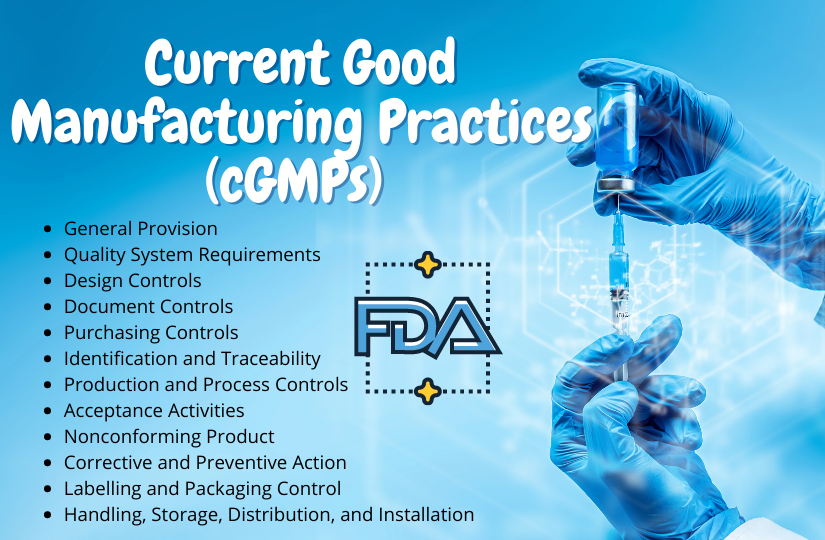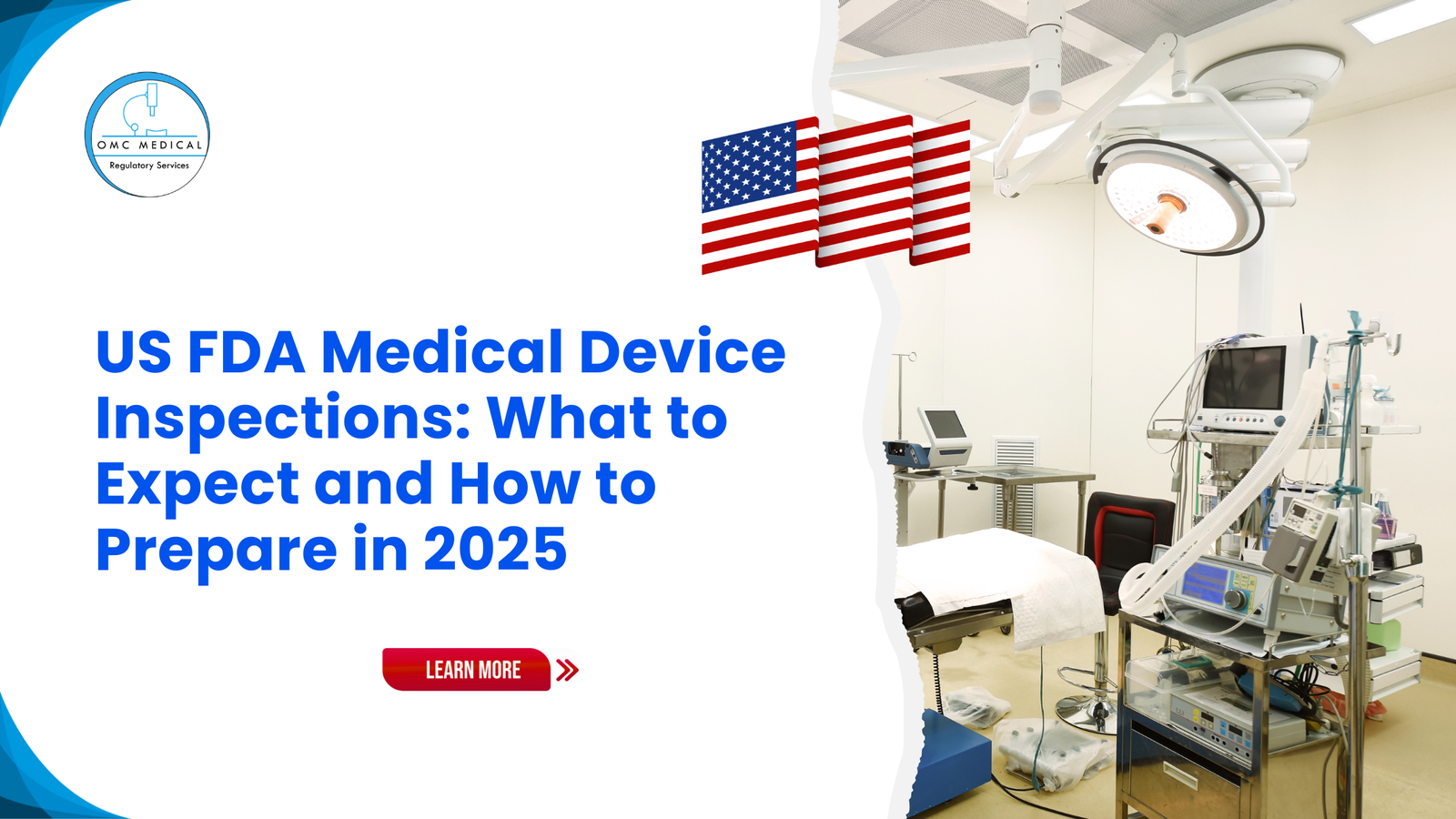The FDA introduced current Good Manufacturing practices (cGMP) to maintain a system that provides proper design, monitoring, and control of manufacturing processes and facilities.
The cGMP standards ensure products’ identity, strength, quality, and purity by requiring manufacturers to maintain proper control over their manufacturing processes.
This system helps the manufacturer avoid as many failures and errors as possible. The “C” in cGMP refers to “current,” which means that organisations must employ up-to-date technologies and systems to comply with the rules.
The cGMP is subdivided into the following chapters:
- Subpart A-General Provisions (§§ 820.1 – 820.5)
- Subpart B – Quality System Requirements (§§ 820.20 – 820.25)
- Subpart C – Design Controls (§ 820.30)
- Subpart D – Document Controls (§ 820.40)
- Subpart E – Purchasing Controls (§ 820.50)
- Subpart F – Identification and Traceability (§§ 820.60 – 820.65)
- Subpart G – Production and Process Controls (§§ 820.70 – 820.75)
- Subpart H – Acceptance Activities (§§ 820.80 – 820.86)
- Subpart I – Nonconforming Product (§ 820.90)
- Subpart J – Corrective and Preventive Action (§ 820.100)
- Subpart K – Labelling and Packaging Control (§§ 820.120 – 820.130)
- Subpart L – Handling, Storage, Distribution, and Installation (§§ 820.140 – 820.170)
- Subpart M – Records (§§ 820.180 – 820.198)
- Subpart N – Servicing (§ 820.200)
- Subpart O – Statistical Techniques (§ 820.250)
cGMPs Quality System Requirements
- Establishing appropriate policies for maintaining quality requirements and ensuring they are followed in responsibility of the manufacturer. Handling matters such as the responsibility, authority, and interrelation of all personnel, resource allocation, quality plan, quality system procedure, and instructions is the manufacturer’s responsibility.
- A representative must be appointed who ensures the quality requirements and periodically reports its performance to the executive management.
- Quality audits must be mandatorily performed by personnel who are not directly responsible for the matters under audit and reports of such audits must be documented and shared with executive management. Ensuring availability of trained personnel for each task, and training activities for the same is must.
Design Controls
- Every manufacturer, irrespective of any device class should maintain a specific design plan that must include design input requirements and the development process, which should be reviewed and updated periodically.
- The manufacturer must maintain procedures to define and document design input and output data and be reviewed regularly. The results of design reviews must be documented in the design history file (DHF).
- The manufacturer is also expected to maintain procedures for verification and validation of the design procedure. Design changes and procedures for the changes to product specifications must be part of the manufacturer’s design control plan.
All information listed above must be part of the manufacturer’s Design History File (DHF).
Document Controls
This subpart describes how documents should be verified before distribution.
- A responsible for checking document adequacy before circulation with their signature and date of verification is must and should be documented.
- Any changes to the documents can be verified by an individual(s) in the same function or organisation unless specifically designated and changes made are to be communicated to the concerned person.
- Information such as the description of the change, identification of the affected documents, the signature of the approving individual(s), the approval date, and when the change becomes effective must be part of the change record.
Purchasing Controls
This subpart describes that each manufacturer must maintain a procedure to verify if all purchased or received products conform to the specified requirements.
- Manufacturers must evaluate and document their suppliers, contractors, and consultants for all specified requirements, including quality requirements. The type of control over these operators must be defined, and a list of permissible operators should be documented.
- It is a must to maintain data with a clear description or reference to specified requirements, including servicing. Purchasing data shall be approved in accordance with Sec 820.40.
Identification and Traceability
This subpart describes identification and traceability requirements.
- Manufacturers must establish methods to identify the product during all stages of receipt, production, distribution, and installation to prevent mix-ups. Devices intended for surgical implants or to support or sustain life must have procedures to identify the product with a control number 0f each unit, lot or batch of finished devices. This will help while taking corrective action. Such identification details must be documented in DHR.
Production and Process Controls
This subpart describes how the manufacturer should develop, conduct, control and monitor production processes to ensure that a device conforms to its specifications.
- Details of Documented instructions, SOPs, methods that define and control the manner of production, monitoring and control of process parameters, compliance with specified standards, and approval processes criteria for workmanship must be included where process control is required.
- Production and process changes must be verified and validated according to Sec 820.75, and changes shall be approved in accordance with Sec 820.40. There must be proper procedure to maintain its working if environmental control is applicable.
- Details on personnel, contamination control, buildings, Equipment, Maintenance schedule, Inspection, Adjustment, Manufacturing material and automated processes are mentioned in detail in this section.
Section 820.72 describes inspection, measuring and test equipment. Various aspects from the control of inspection, measuring and testing equipment to its calibration and records are discussed in detail in this section.
Section 820.75 describes process validation. The processes must be verified with a high degree of assurance and approved according to established procedures.
Manufacturers must maintain procedures for monitoring and control of validated processes. Any changes or deviations in the process should be reviewed, evaluated, revalidated if necessary, and appropriately documented.
Acceptance Activities
This subpart describes the process of receiving in-process and finished device acceptance and acceptance status in detail. Finished products shall not be released for distribution until:
(1) The activities required in the DMR are completed
(2) the associated data and documentation are reviewed
(3) the release is authorised by the signature of a designated individual(s)
(4) the authorisation is dated.
The acceptance record shall include the following details:
(1) The acceptance activities performed
(2) the dates acceptance activities are performed
(3) the results
(4) the signature of the individual(s) conducting the acceptance
activities
(5) where appropriate, the equipment used. These records shall be part of
the DHR
To ensure that the product that has passed the required acceptance activities is distributed, used, or installed, the identification of acceptance status must be maintained throughout the product’s production, packaging, labelling, installation, and service.
Nonconforming Products
This subpart describes the control of nonconforming products and nonconformity review and disposition.
- A procedure to identify, document, evaluate, segregate, and disposition a nonconforming product must be maintained by the manufacturer. The evaluation and investigation results must be documented.
- The manufacturer must also establish and maintain a procedure for rework, such as retesting and re-evaluating nonconforming products after rework. All these activities must be documented in the DHR (Device History Record).
Corrective and Preventive Action
This subpart describes corrective and preventive actions. Procedures such as analysing, investigating, identifying, verifying, implementing, ensuring correct information, and submitting relevant information for all processes must be established and followed by the manufacturer.
All the nonconforming products must be reported and documented. During the verification process, the manufacturer must ensure that the corrective and preventive action should be effective and should not adversely affect the finished device.
Labelling and Packaging Control
This subpart describes how to establish and maintain procedures to control labelling activities.
- Labels affixed to the device must remain legible throughout the manufacturing process and until it is delivered to the end-user.
- Manufacturers must establish a procedure for labelling inspection, labelling storage, and labelling operations. During the inspection process, the responsible person must ensure the correct unique device identifier (UDI) or universal product code (UPC), expiration date, control number, storage instructions, handling instructions, and any additional processing instructions present on the label.
- A control number as per Sec820.65 for each product must be part of the labelling. This subpart also mentions that the manufacturer must establish a proper procedure for device packaging during different stages of the manufacturing process.
Handling, Storage, Distribution, and Installation
This subpart describes the product’s handling, storage, distribution, and installation.
- During storage and handling, the manufacturer must ensure that mix-ups, damage, deterioration, contamination or other adverse effects must not affect the product.
- Manufacturers must establish a procedure to authorise the receipt and dispatch the product to storage rooms. Manufacturers must maintain distribution records which should include the following:
(1) The name and address of the initial consignee
(2) The identification and quantity of devices shipped
(3) The date shipped
(4) Any control number(s) used.
Further, Details on Installation procedures to be adopted by the manufacturer are given in detail.
Records
This subpart describes the requirements of record keeping.
- The manufacturer is expected to maintain confidentiality if required and a set record retention period for all records as per the nature of the document.
- It shall include device specifications, production process, Quality assurance procedures, packaging, labelling, installation, maintenance, and servicing procedures and methods.
- The manufacturer must also maintain a Device history record (DHR) which should contain the following information:
(a) The dates of manufacture
(b) The quantity manufactured
(c) The quantity released for distribution
(d) The acceptance records which demonstrate the device is manufactured in accordance with the DMR
(e) The primary identification label and labelling used for each
production unit
(f) Any unique device identifier (UDI) or universal product code (UPC),
and any other device identification(s) and control number(s) used
Detailed information on complaint files and Quality system records are also included in this subpart.
Servicing
This subpart describes servicing requirements.
- Manufacturers are expected to analyse service reports with appropriate statistical methodology as per Sec 820.100.
- Any service report that must be reported to the FDA under part 803 of the CGMP document shall automatically consider the report a complaint and proceed according to Sec 820.198. In general, the service report must include the following details:
(1) The name of the device serviced
(2) Any unique device identifier (UDI) or universal product code (UPC)
and any other device identification(s) and control number(s) used
(3) The date of service
(4) The individual(s) servicing the device
(5) The service performed
(6) The test and inspection data
The last subpart of the CGMP document gives details of Statistical Techniques to be used while following the CGMP guidelines.
FAQs
What are the field safety corrective actions of the FDA?
FDA has a stringent FSCA requirement. Refer to our article to understand the FDA’s field safety corrective action procedures.
Are there exemptions from GMP?
Medical devices published in the Federal Register and codified in 21 CFR 862 to 892 and exempted by FDA classification regulations are exempted from following the GMP requirements. However, manufacturers of finished devices must maintain complaint files (21 CFR 820.198) and general requirements concerning records (21 CFR 820.180). Medical devices manufactured under an investigational device exemption (IDE) are not exempt from design control requirements under 21 CFR 820.30 of the QS regulation.
Is it acceptable for a manufacturer to produce sterile products by aseptic processing to rely solely on ISO standards to qualify the facility?
No, in addition to the ISO standards it is required that the manufacturer follows applicable FDA regulations.
Disclaimer: Regulations/legislations are subjected to changes from time to time and the author claims no responsibility for the accuracy of information.







